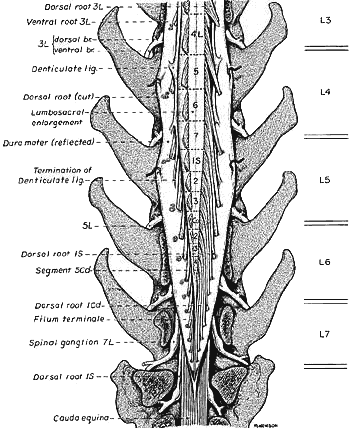Vertebral laminae have been removed (laminectomy); dura mater is incised and reflected, and dorsal roots are cut on the left side to show denticulate ligament.
At caudal levels of spinal cord, spinal segments progressively shorten in length, including segments of the lumbosacral enlargement (L4, L5, L6, L7, S1). The region of spinal cord caudal to the enlargement is called conus medullaris. A terminal filament composed of glial cells extends caudally from the end of the spinal cord. The subarachnoid space ends in the sacrum.
Sacral and caudal spinal roots traveling caudally are collectively known as the cauda equina. Damage to the cauda equina results in clinical signs related to the tail and pelvic viscera.
Click for information about the relationship between spinal segments and vertebrae for the caudal spinal cord.
